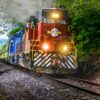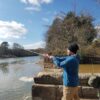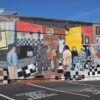
A Sight To See: Sandhill Cranes at the Hiwassee Refuge
Sandhill Cranes at Hiwassee Refuge
In recent years, the Hiwassee Refuge near Birchwood, Tennessee, has become a popular location for viewing large flocks of migrating and wintering sandhill cranes.
Up from just 20 birds in 1968, over 14,000 of the cranes now gather there each winter.
Though present from mid-October through February, and possibly into March, their numbers tend to peak in January. The refuge is one of only two major staging areas for the eastern population of sandhill cranes during spring and fall migrations, the other being the Jasper-Pulaski Fish and Wildlife Area in Indiana. The cranes nest in the regions around Lake Michigan and Lake Superior, as well as across Canada and Alaska. While the majority of the eastern population winters in Florida, since the 1990s an increasing number have been spending the winter in places farther north like southeastern Tennessee and northern Alabama.
At a height of over four feet and with a wingspan of six feet, the sandhill crane is one of Tennessee’s largest birds. Their distinctive call, or “bugle,” can be heard for over a mile. Sandhills are omnivores, eating seeds, berries, grains, insects, and small mammals. They tend to congregate in marsh areas and grain fields, and generally roost at night along shallow water shorelines.
The 6,000-acre Hiwassee Refuge, managed by the Tennessee Wildlife Resources Agency (TWRA), is located on Chickamauga Lake at the confluence of the Hiwassee and Tennessee rivers, near the site of the historic Blythe Ferry, and includes the 400-acre Hiwassee Island. It’s an official stop on the Tennessee Birding Trail. About 750 acres of land in the refuge are agricultural fields that provide food for the cranes, with crops planted including corn, soybeans, wheat, milo, millet, and buckwheat. The remaining land area, about 1,750 acres, is primarily mixed pine and hardwood forest. About 3,500 acres of the refuge is water.

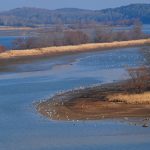

The refuge lands are closed to visitors between Nov. 15 and the end of February, but an observation platform remains open during daylight hours year-round from which you can get good views of fields full of sandhill cranes, as well as other bird life. Visitors may even occasionally get a glimpse of an endangered whooping crane. It’s considered one of the top five locations in the state for bald eagle numbers. According to TWRA, golden eagles are also seen at the refuge. Other birds likely to be spotted in the water or on sandbars and shorelines include great blue herons, gulls, cormorants, and a variety of ducks. Osprey are commonly seen here from March through September. And a wild turkey or two may show up in the fields.
The Tennessee Sandhill Crane Festival
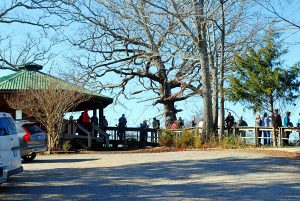 The TWRA is the primary sponsor of the annual Tennessee Sandhill Crane Festival, held on the third weekend of January at the Hiwassee Refuge and the nearby Birchwood Community Center, located at 5623 TN Hwy. 60. The 2020 festival is scheduled for January 18-19. The free event features music, special programs, and children’s activities at the Birchwood Community Center, and bus rides to the refuge observation platform, three miles away. Wildlife and birding experts will be on hand at the refuge to share information and viewing scopes. During the festival, you aren’t allowed to drive your own vehicle to the observation area, but are required to take the bus, which runs at regular intervals to and from the Birchwood Community Center. As time for the festival nears, find more information about plans here. Of course, if you can’t make it that weekend or prefer it less crowded, you can visit the Hiwassee Refuge observation area or the neighboring Cherokee Removal Memorial Park overlook on your own any other time.
The TWRA is the primary sponsor of the annual Tennessee Sandhill Crane Festival, held on the third weekend of January at the Hiwassee Refuge and the nearby Birchwood Community Center, located at 5623 TN Hwy. 60. The 2020 festival is scheduled for January 18-19. The free event features music, special programs, and children’s activities at the Birchwood Community Center, and bus rides to the refuge observation platform, three miles away. Wildlife and birding experts will be on hand at the refuge to share information and viewing scopes. During the festival, you aren’t allowed to drive your own vehicle to the observation area, but are required to take the bus, which runs at regular intervals to and from the Birchwood Community Center. As time for the festival nears, find more information about plans here. Of course, if you can’t make it that weekend or prefer it less crowded, you can visit the Hiwassee Refuge observation area or the neighboring Cherokee Removal Memorial Park overlook on your own any other time.
Where nature and history converge
At Blythe Ferry, adjacent to the Hiwassee Refuge, the Cherokee Removal Memorial Park provides a roofed overlook on a high bluff above the Tennessee River, which affords a view of the river and part of Hiwassee Island. This is a good spot for seeing cranes, bald eagles and other birds, including possibly white pelicans. The park commemorates the forced removal of the Cherokee on the infamous Trail of Tears in 1838.
Blythe Ferry, which played a significant role in the removal event, operated from 1809 to 1994, when it was replaced with a nearby bridge.
Hiwassee Island, about twice its current size before the formation of Chickamauga Lake, was occupied by humans for hundreds of years. Its residents once included a young Sam Houston. Union troops stored grain on the island during the Civil War.

The grounds of the Cherokee Removal Memorial Park are open daily during daylight hours. Find visitor center hours, directions,and other information here.
Find directions to the observation platform and more information about the Hiwassee Refuge here.
Article by Bob Butters

